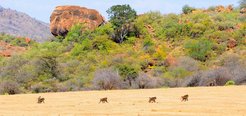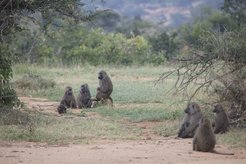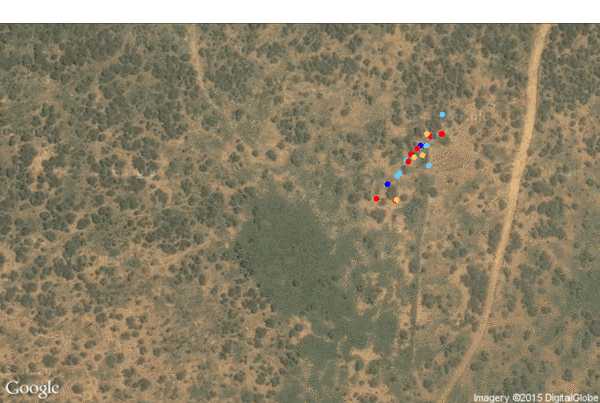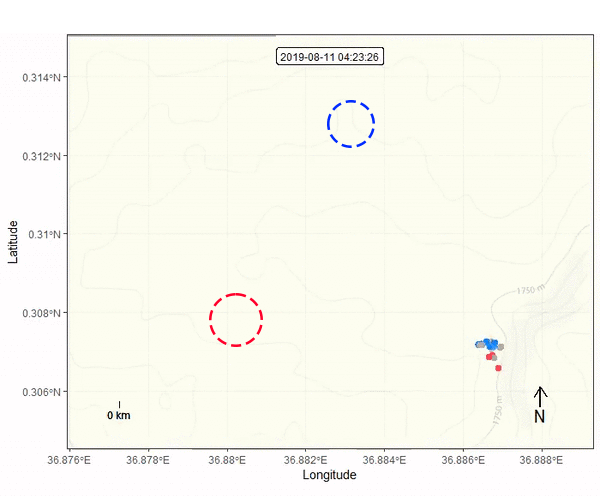
How do troops of baboons make decisions?
To stay together, group-living animals must reach consensus about where to go and what to do. Because individuals differ in their needs and capabilities, group members’ preferences will not always align. Resolving such conflicts of interest is a key challenge to living in stable, socially complex societies. How is influence exerted? How is consensus achieved?


Making good decisions is essential for survival and reproduction, but in social species, individuals do not decide alone. As they traverse heterogenous physical landscapes to find food or avoid predators, they must also navigate the complex social dynamics of their group. Critical decisions about where to go next must be negotiated among individuals with divergent interests, differing levels of motivation, and, sometimes, significant power asymmetries. To understand how such asymmetries shape decision-making in group-living animals, we investigate how troops of wild olive baboons reach (or fail to reach!) consensus across behavioral contexts and at different spatial and temporal scales. By scaling from the individual- to the group- to the population-level, we hope to learn about general behavioral mechanisms that underlie the evolution of complex animal societies.
How do groups reach consensus?

Groups of animals navigating the landscape in search of food and other resources benefit from remaining together. As members of a group, individuals gain protection from predators, access to information from group-mates, and increased competitive ability. To obtain these benefits, however, they must coordinate their activities; otherwise, groups fragment as individuals pursue diverging patterns of behavior and movement. Collective movement decisions are a primary challenge of group-living, and how group-mates overcome conflicts of interest and reach consensus is central to understanding the evolution of complex societies like our own. Does an influential leader decide where to go and what to do? Or are the preferences of all group members integrated—democratically—into a shared decision?
To answer these questions, we use GPS-technology to simultaneously monitor the movements of entire wild baboon troops at very high spatio-temporal resolution. Learn here how we track baboons!
Our research team has made an exciting finding: baboon decisions are democratic—group-members follow the majority rather than a leader! Watch the video below to learn about their decision-making process.
How baboons make decisions
Untamed Science has created a great video explaining the decision-making process on the move.
Who exerts influence?
The failure of high-ranking individuals to dominate movement decisions highlights an important distinction between social status and leadership in wild baboons. How influence is exerted can vary in different settings. Likewise, how groups solve conflicts of interest varies across contexts. A dominant individual may forage on the best patches first, but apparently does not exert despotic power when it comes to movement decisions.

To test for the influence of individuals on the group during conflicts of interest, we gave access to blue-marked feeders to individuals that are represented by blue dots, and access to the red marked feeders to individuals represented by red dots.
Can some baboons exert outsized influence or bias group decisions in their favor? And if so, how? We have developed an experimental framework that allows us to tackle these difficult questions in ecologically and socially relevant field settings. With our custom-designed PIT-tag (Passive Integrated Transponder) controlled, automated feeders, we can control which group members have access to highly desirable food items. Because baboons quickly develop a preference for experimental feeding patches where they can access food (and a disinclination to visit patches where they cannot!), we know exactly which individuals will try to sway the group to move towards a specific food patch. By manipulating motivation and creating conflicts of interest within baboon troops, we can tease apart how individual traits (e.g. body size), individual state (e.g., hunger), social characteristics (e.g., dominance status) and inter-individual relationships (e.g., social bonds) affect the influence an individual has on group movement decisions.
In addition to movement, we observe fine-scale behavior to understand what makes initiation attempts successful. When individuals forage or take a nap, groom each other or fight, the motivation to follow others might differ. We record individual’s body movements with accelerometers and use supervised machine learning algorithms to infer individual behavior, as well as interactions among individuals and group-level behaviors. Ultimately, we aim to use this tool-kit to compare collective decision-making in baboons living in groups of different sizes, in different habitats, and even with different social structures, to better understand this critically important process that is central to any functioning society—animal or human.
Want to learn more?
Sleeping in Groups
Further reading & Cited articles
Shared decision-making drives collective movement in wild baboons
Coordination Event Detection and Initiator Identification in Time Series Data
A Framework For Identifying Group Behavior Of Wild Animals
Identifying Traits of Leaders in Movement Initiation
Inferring influence and leadership in moving animal groups
Terrestrial animal tracking as an eye on life and planet
Blood Biochemical Reference Intervals for Free-Ranging Olive Baboons (Papio anubis) in Kenya

















